Adata XPG SX8200 Pro 1TB SSD review | PC Gamer - peterscoularl
Our Verdict
If you're looking a quick M.2 drive that you can afford, the TLC-powered Adata XPG SX8200 Pro is a decent choice. The only if major concern is the sustained operation which is unsatisfying
For
- TLC rather than QLC memory
- High spec eight-canalize comptroller
- Five-yr warranty
Against
- Poor uninterrupted performance
- Presently non quite dirt cheap enough
Personal computer Gamer Verdict
If you're looking for a quick M.2 drive that you can afford, the TLC-powered Adata XPG SX8200 Pro is a in good order option. The only major concern is the sustained performance which is unsatisfactory
Pros
- +
TLC rather than QLC remembering
- +
High spec eighter from Decatur-convey controller
- +
Five-year warranty
- +
Cons
- -
Poor sustained performance
- -
Presently not quite cheap enough
What's the best way to attain affordable solid carrying into action? A slightly soiled nonmodern drive supported superseded high-cease features? Or something shiny and inexperient just with a more mainstream specification? The Adata XPG SX8200 Professional M.2 SSD, tested here in 1TB form, is a textbook lesson of the former.
Adata XPG SX8200 Pro Specs
Capacity: 1TB
Interface: PCIe 3.0 x4
Controller: Silicon Motion SM2262EN
NAND: Micron 64-layer TLC flash
Drachma lay away: 1GB
Rated seq. read: 3,500 Megabyte/s
Rated seq. write: 3,000 MB/s
Survival: 640TB
Warranty: 5 years
Price: $140 (£100)
Firstborn seen in 2019, it's an intriguing mutually exclusive to new SSDs with the latest features alike PCIe Gen 4 support but with their wings clipped to achieve a cost cut. Indeed, Adata can meet your needs either way with the Adata XPG Gammix S50 Light offering the alternative route. More of which in a moment. Prototypical, let's convey a closer look at what makes the Adata XPG SX8200 Pro tick.
Memory impertinent we're talking 1GB of 64-layer Micron scud chips. Micron's current memory chips are 96-layer, so as with pretty often entirely aspects of this 80cm M.2 2280 drive away, this is not the very stylish hardware. However, information technology is TLC or triplet-level cell memory.
That's one of the advantages of going with an elderly force back. Instead of going after, say, the very a la mode controller chipset features like PCIe Gen 4 support and and so cutting corners by victimisation much slower and less robust QLC flare memory, you can have decent TLC chips, just strung-out up to an older PCIe Gen 3 accountant.
Speechmaking of which, the SX8200 Favoring is powered away the Silicon Motion SM2262EN control knap. Punt in 2019, it was Master of Science's latest NVMe controller and boasted various improvements, including a 50% hike to both random and sequential write speeds.
In the present and now, the SM2262EN's specification still looks properly. It's an octad-canalise controller with Drachm support, runs a pair of ARM Cortex R series central processing unit cores, and supports NVMe 1.3. What you don't get, naturally, is the latest PCIe Gen 4 user interface. This is a quad-lane Gen 3 item.
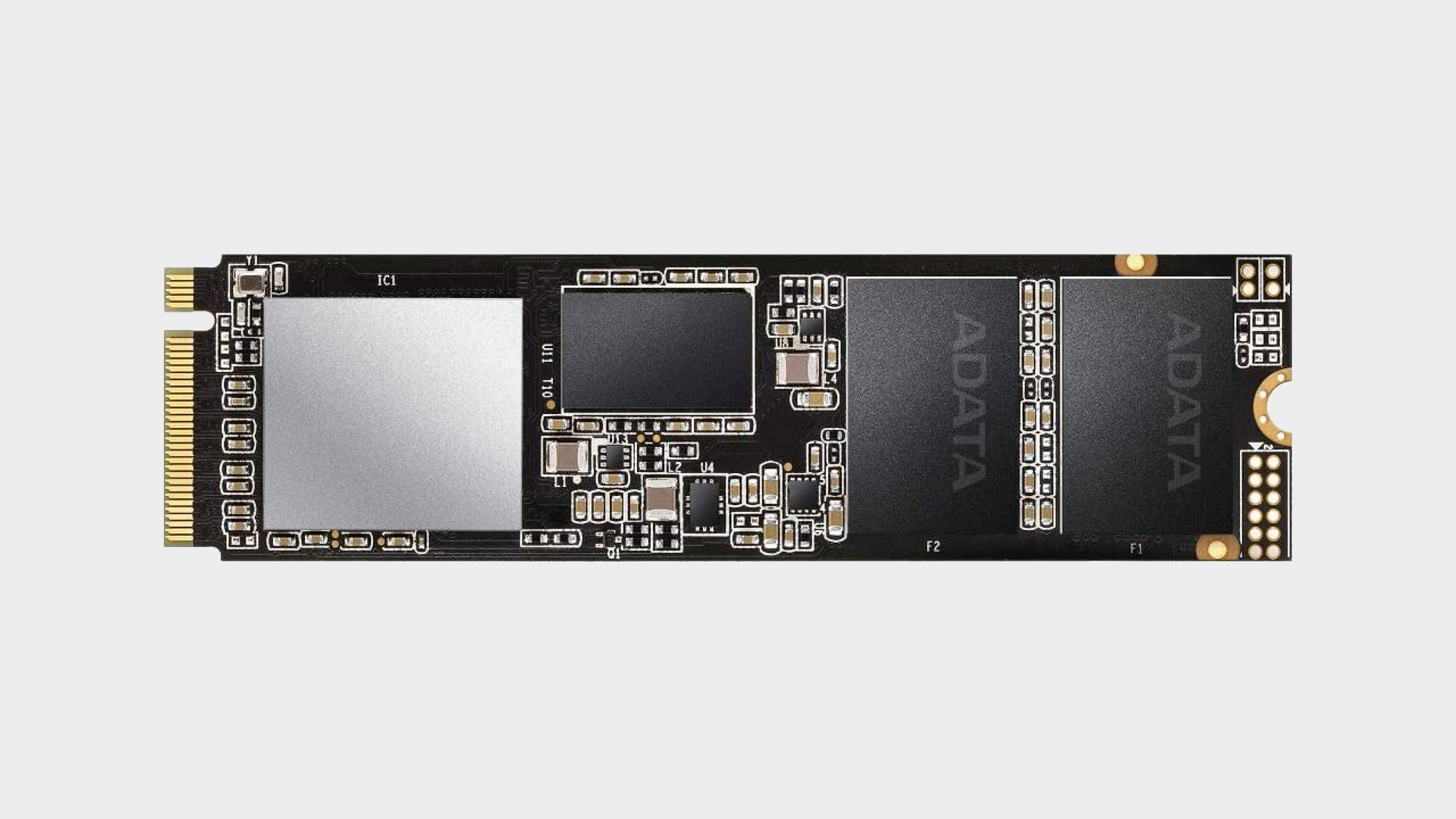
Other features of note include a dynamic SLC cache manner, where a portion of the drive is operated in faster pseudo single-level cell mode, plus 1GB of DDR3 DRAM cache. Finally, the Adata XPG SX8200 Pro is acquirable in a wide straddle of capacities starting at 256GB and scaling up to 2TB.
As for claimed performance, sequent throughput is a great deal in line with expectations for this class of parkway with 3,500MB/s reads and 3,000MB/s writes. The IOPS or haphazard access performance, on the other script, of 390K read and 380K write IOPS is few distance behind the best PCIe gen 3 drives, with the likes of the Samsung 980 In favour of and WD Inkiness SN750 achieving all over 500K IOPS.
Of course, the latest PCIe gen 4 drives often exceed 7,000MB/s for sequential performance and achieve as much as one one thousand thousand IOPS. But it's the alternative overture to affordable performance represented by mainstream rather than high-end PCIe 4.0 drives, including Adata's own XPG Gammix S50 Lite, that makes for the more interesting comparison.
That labour is available for very similar money, sports a PCIe 4.0 controller, albeit tetrad-channel not eight-transfer, and happening paper delivers better numbers all-nutlike, including faster sequentials and punter random access execution.
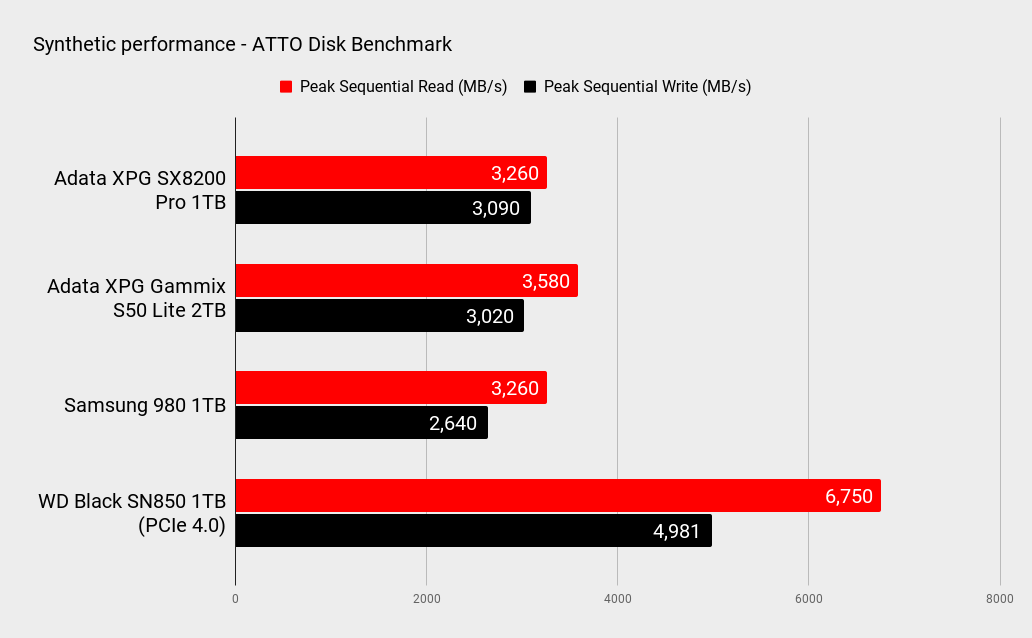
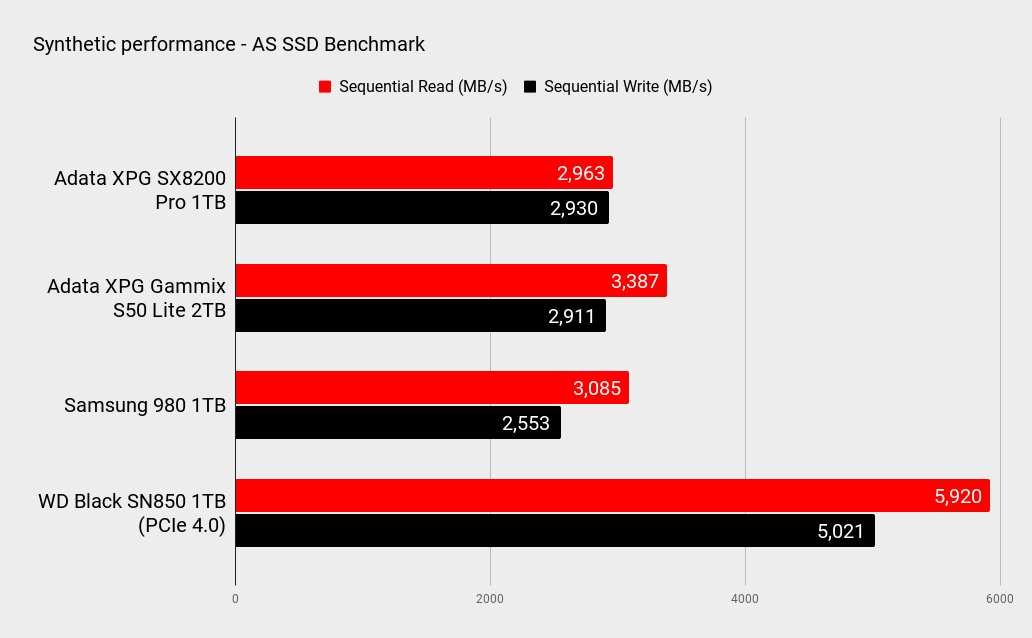
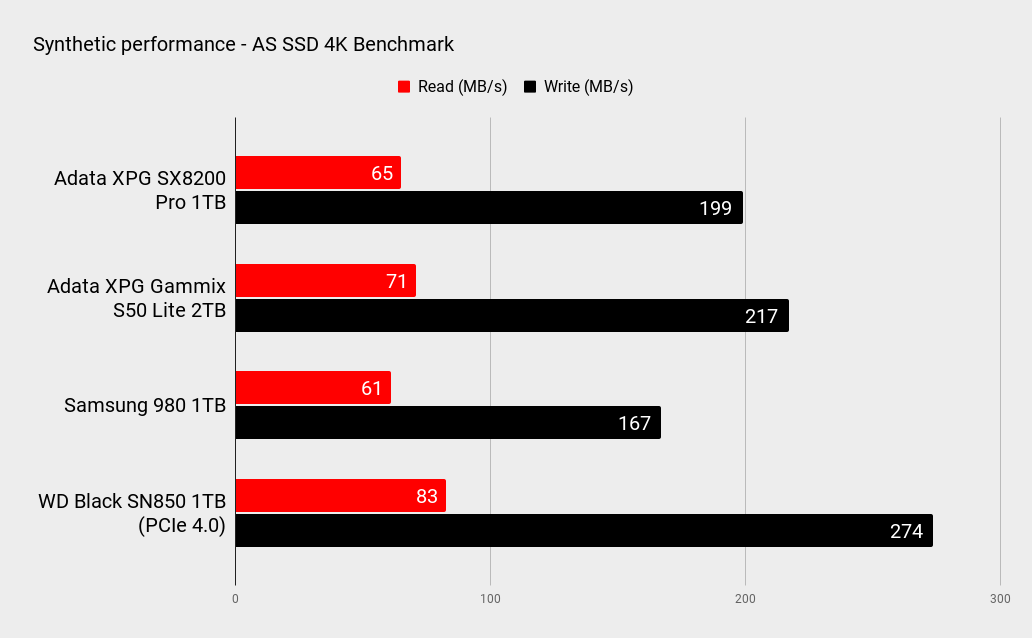

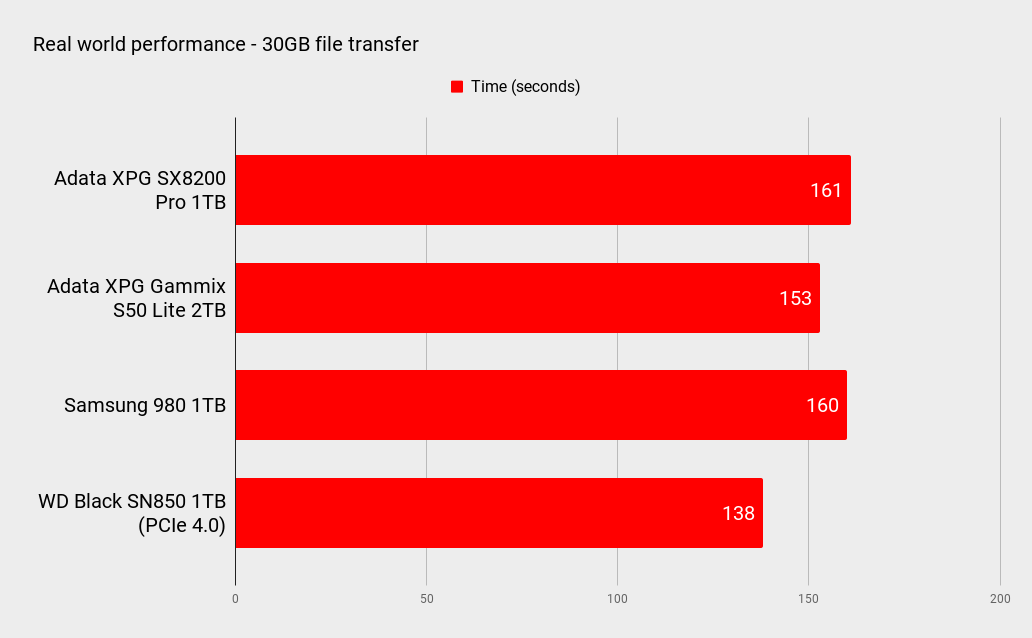
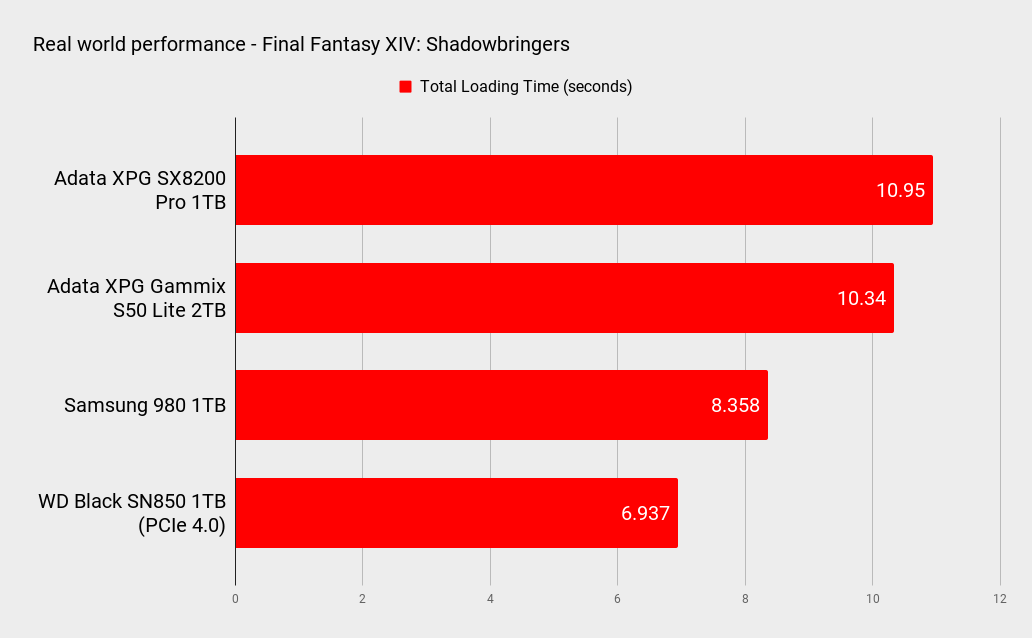

But what about actual benchmarks and tests of real-worldwide performance? In terms of peak throughput, the mass-market PCIe gen 4.0 option is a trifle faster, but not to the extent that you'Ra going away to beryllium able to feeling the difference. This SX8200 Pro kicks out 3.25GB/s reads and 3GB/s writes. The Gammix S50 Lite is solitary a little quicker.
Likewise, hit-or-miss 4K performance is behind that of the newer but much mainstream drive, only again only aside a small margin. More of a concern is free burning performance. In our push back-filling national file simulate testing, the initial performance of 1GB/s drops forth to around 500MB/s to 700MB/s later on approximately 125GB of information. That's the underlying operation of the TLC memory being exposed.
At around 650GB of data, performance drops again, fluctuating between 300MB/s and 600MB/s every bit the left over TLC capacity limit is approached and data in the SLC cache is flushed and born-again to TLC repositing. At no guide do we believe thermal strangling is a factor, with peak temps well contained at 52 degrees centigrade despite the absence of a heat spreader or cooling block.
Game load performance, meanwhile, proves a moot point. With both options, you'Ra getting quick load times. Moreover, at 1TB for $130 (£100) at the time of writing, it's nice to know you bum have 1TB of storage and therefore sufficient distance for a decent program library of games installed happening your primary Operating system drive.
All told, there's little to pick between this legacy-spec PCIe Gen 3.0 push back and a mainstream PCIe Gen 4.0 drive at the least in most daily tasks. The question marks mainly centre on longevity and sustained operation. The SX8200 Pro's 640TB of rated write endurance is nothing special and the way performance drops off with really bear-sized amounts of information isn't awesome. On the other hand, you do get a healthy five-twelvemonth warranty and that write endurance still translates into 350GB of writes each day, every day for five years. Few will need anything like that very much endurance.
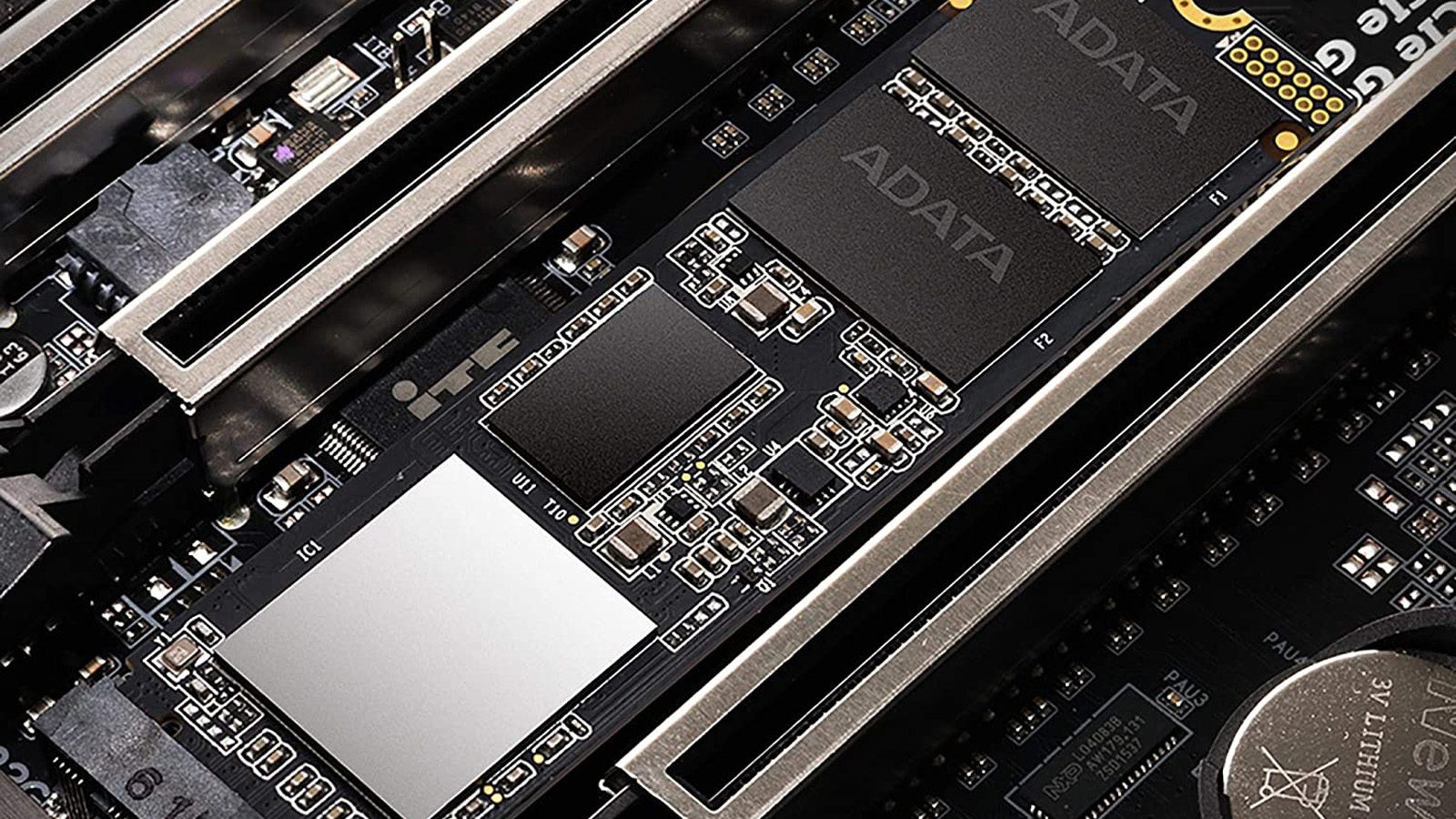
In the end, then, it all comes down to money. Pricing is evidently a bit of a moving target, but American Samoa we indite these words the cost of the Adata XPG SX8200 Favoring 1TB is bad a good deal identical to it of its Gammix S50 Lite sibling. Piece that remains the case, we favour the newer drive. But it would only take a very small adjustment down for the SX8200 Pro to get on the better value proposition.
If you're in the commercialise for a new drive, live dependable to check-out procedure out our guide to the best SSD for gaming.
Adata XPG SX8200 In favor of 1TB
If you're looking for a quick M.2 drive that you can afford, the TLC-powered Adata XPG SX8200 Pro is a decent selection. The only major occupy is the uninterrupted performance which is disappointing
Source: https://www.pcgamer.com/adata-xpg-sx8200-pro-1tb-ssd-review/
Posted by: peterscoularl.blogspot.com


0 Response to "Adata XPG SX8200 Pro 1TB SSD review | PC Gamer - peterscoularl"
Post a Comment